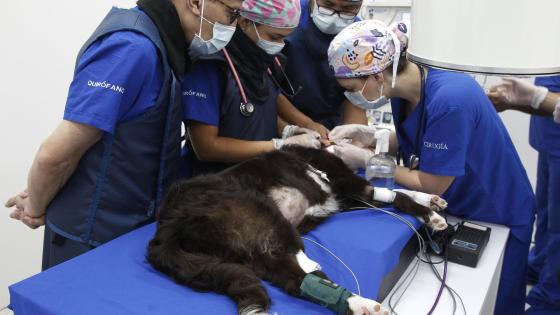The CES University of Medellín successfully performed a pulmonary valvuloplasty on a dog on Monday, the first procedure of this type in Colombia, performed before a diagnosis of pulmonary stenosis, a congenital disease that compromised the health of the animal.
The intervention of “Moka”, a 7-month-old border collie dog, was carried out by an interdisciplinary team made up of 15 people, including professionals in human health and veterinary medicine.
The veterinary doctor and zootechnician María Adelaida Mejía explained to EFE that the procedure is “a catheterization, where a guide is inserted through the right jugular vein to the right side of the heart, exactly towards the pulmonary valve and through various devices a balloon is introduced that inflates and bursts the valve.”
It may interest you: A network that prostituted Colombian women in Spain falls
He specified that the group of experts decided to carry out this intervention, which will allow “Moka” to live more years, to provide a solution to his pathology.
“The expectation is that he will do very well and that he can have a better quality of life”pointed out Mejía, coordinator of the cardiology area at the CES, who remarked that for the first time in the country a procedure was performed that until now had only been performed in Spain, the United States, Chile, Mexico and Brazil.
OPEN THE DOORS TO NEW PROCEDURES
Diego Vanegas, a human cardiologist and hemodynamic specialist, who led the pulmonary valvuloplasty of “Moka”, said that the dog was admitted to the veterinary and animal husbandry center due to decompensation and was diagnosed with pulmonary stenosis, for which a group was formed to study the case and determine the type of intervention.
Through the animal’s heart, they managed to reach the pulmonary circulation and inflate a balloon at the site of the stenosis in order to recover the diameter of the artery and allow flow between the heart and lungs.
“It was a challenge for us as human cardiologists because it is the first time we are faced with a different anatomy. It was a successful procedure, so far with very good results. We look forward to realizing the clinical results in recovery.”maintained the specialist.
Vanegas considered that passing the experience from humans to animals “open the doors” to make new procedures and check that if different forces and science come together, they can be “achieve things that were previously unthinkable”.
He also pointed out that this pathology, “quite often” in dogs, previously it had no possibility of treatment.
In 2020, a group of specialists from CES University successfully implanted a pacemaker in a 9-year-old Maine Coon cat, which had been admitted to the institution due to the risk of death it suffered due to an AV block that caused frequent fainting. .
